Do you have a question about the Weber SPIRIT II E-215 and is the answer not in the manual?
Defines DANGER, WARNING, and CAUTION hazard statements and lists key safety points.
Prohibits installation in vehicles/boats and built-in configurations; warns against modification.
Mandates outdoor use, ventilation, clearances, flammable materials, hot parts, supervision, mitts, movement, and country certification.
Welcomes the user and encourages reading the manual for optimal barbecue experience and registration.
Explains WEBER's voluntary warranty, customer rights, and warranty coverage periods.
Outlines owner's duties for warranty, including registration, assembly, and maintenance.
Details how to handle warranty claims and lists conditions that void the warranty.
Device for monitoring internal barbecue temperature to adjust heat as needed.
Rack to keep food warm or toast burger buns while the main meal cooks.
Removable grate insert allowing transformation into griddle, roaster, pizza stone, or other accessories.
Tables for keeping items handy, with hooks for tools; one table folds down.
Explains direct heat for quick cooking and indirect heat for larger/delicate items, with setup diagrams.
Provides advice on preheating, grate cleaning, preparation, lid use, flipping food, temperature monitoring, and experimentation.
Recommends specific tools like barbecue mitts, spatulas, and timers for safe and effective grilling.
Explains LPG, safe handling tips for cylinders, regulator function, and hose requirements.
Step-by-step guide for placing the barbecue and connecting the LPG cylinder, including passing the hose.
Details connecting the regulator to the cylinder using various methods and placing the cylinder safely.
Instructions for checking fittings with soap and water solution, identifying leaks, and rinsing connections.
Procedure for safely disconnecting the regulator from the LPG cylinder, emphasizing turning off the valve first.
Instructions for the first-time burn-off for 20 minutes at high heat before initial use.
Essential daily checks including grease management, hose inspection, and preheating the barbecue.
Step-by-step guide for using the CROSSOVER ignition system, including safety warnings and match lighting backup.
Procedure for safely turning off all burners and the gas supply at the LPG cylinder.
General advice on why and how often to clean the barbecue for optimal performance.
Specific instructions for cleaning the lid, cooking grates, FLAVORIZER BARS, burner ports, and spider screens.
Details on cleaning the cookbox interior and the grease management system components.
Guidance for cleaning stainless steel, painted/enamelled, and plastic surfaces, including special environments.
Guides users through diagnosing ignition issues by checking gas flow and electronic ignition components.
Instructions for troubleshooting the electronic ignition system by checking the battery and wires.
Addresses problems like uneven heating, low flame, or erratic flame patterns due to regulator or burner issues.
Explains how obstructed spider screens affect flame pattern and how to clean them.
Advises on checking for damaged seals in LPG cylinder valves when a gas smell is detected.
Clarifies that lid 'peeling' is carbon build-up, not paint, and advises on managing flare-ups through cleaning and preheating.
Provides recommended cooking times for various meats, poultry, seafood, and vegetables based on thickness and heat method.
Lists contact details and service emails for Weber in various countries and regions.
Defines DANGER, WARNING, and CAUTION hazard statements and lists key safety points.
Prohibits installation in vehicles/boats and built-in configurations; warns against modification.
Mandates outdoor use, ventilation, clearances, flammable materials, hot parts, supervision, mitts, movement, and country certification.
Welcomes the user and encourages reading the manual for optimal barbecue experience and registration.
Explains WEBER's voluntary warranty, customer rights, and warranty coverage periods.
Outlines owner's duties for warranty, including registration, assembly, and maintenance.
Details how to handle warranty claims and lists conditions that void the warranty.
Device for monitoring internal barbecue temperature to adjust heat as needed.
Rack to keep food warm or toast burger buns while the main meal cooks.
Removable grate insert allowing transformation into griddle, roaster, pizza stone, or other accessories.
Tables for keeping items handy, with hooks for tools; one table folds down.
Explains direct heat for quick cooking and indirect heat for larger/delicate items, with setup diagrams.
Provides advice on preheating, grate cleaning, preparation, lid use, flipping food, temperature monitoring, and experimentation.
Recommends specific tools like barbecue mitts, spatulas, and timers for safe and effective grilling.
Explains LPG, safe handling tips for cylinders, regulator function, and hose requirements.
Step-by-step guide for placing the barbecue and connecting the LPG cylinder, including passing the hose.
Details connecting the regulator to the cylinder using various methods and placing the cylinder safely.
Instructions for checking fittings with soap and water solution, identifying leaks, and rinsing connections.
Procedure for safely disconnecting the regulator from the LPG cylinder, emphasizing turning off the valve first.
Instructions for the first-time burn-off for 20 minutes at high heat before initial use.
Essential daily checks including grease management, hose inspection, and preheating the barbecue.
Step-by-step guide for using the CROSSOVER ignition system, including safety warnings and match lighting backup.
Procedure for safely turning off all burners and the gas supply at the LPG cylinder.
General advice on why and how often to clean the barbecue for optimal performance.
Specific instructions for cleaning the lid, cooking grates, FLAVORIZER BARS, burner ports, and spider screens.
Details on cleaning the cookbox interior and the grease management system components.
Guidance for cleaning stainless steel, painted/enamelled, and plastic surfaces, including special environments.
Guides users through diagnosing ignition issues by checking gas flow and electronic ignition components.
Instructions for troubleshooting the electronic ignition system by checking the battery and wires.
Addresses problems like uneven heating, low flame, or erratic flame patterns due to regulator or burner issues.
Explains how obstructed spider screens affect flame pattern and how to clean them.
Advises on checking for damaged seals in LPG cylinder valves when a gas smell is detected.
Clarifies that lid 'peeling' is carbon build-up, not paint, and advises on managing flare-ups through cleaning and preheating.
Provides recommended cooking times for various meats, poultry, seafood, and vegetables based on thickness and heat method.
Lists contact details and service emails for Weber in various countries and regions.
| Main Burners | 2 |
|---|---|
| BTU-per-hour Input | 26, 500 |
| Burner Material | Stainless steel |
| Grate Material | Porcelain-enameled cast iron |
| Ignition | Electronic Crossover ignition system |
| Total Cooking Area | 450 sq in |
| Primary Cooking Area | 360 sq in |
| Warming Rack Area | 90 sq in |
| Fuel Type | Propane |
| Weight | 103 lbs |
| Warranty | 10 years (excluding normal wear and tear and subject to additional terms and conditions in the warranty) |
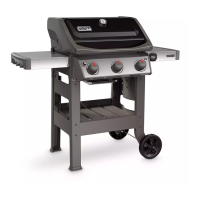

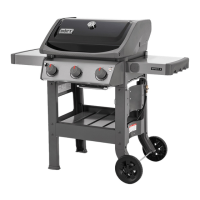
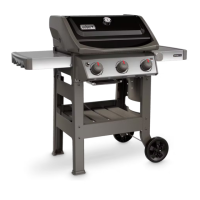
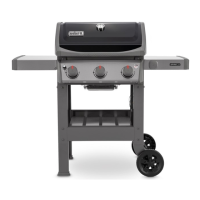
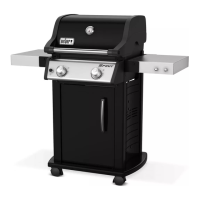
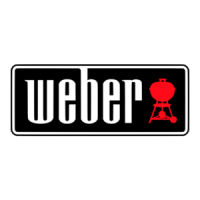
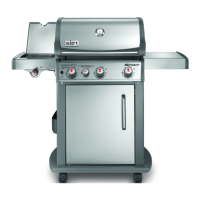


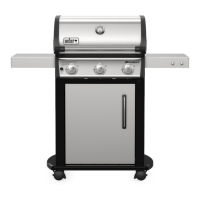
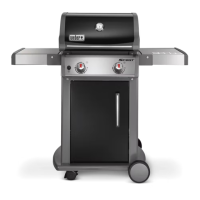
